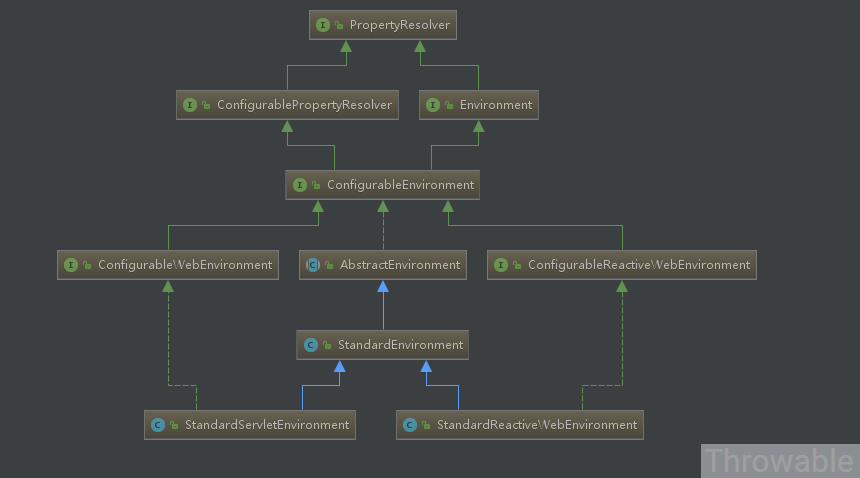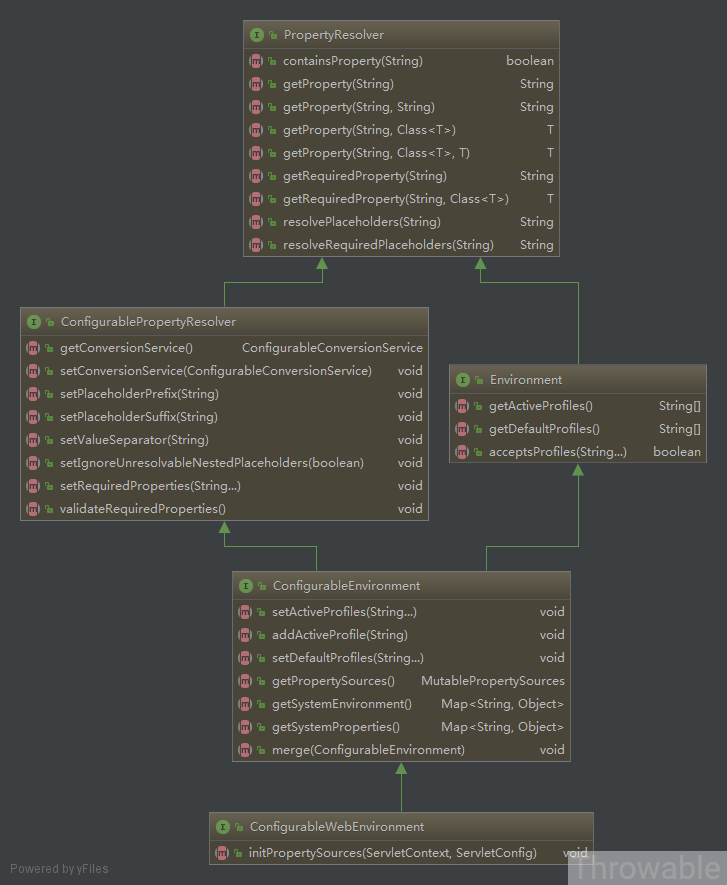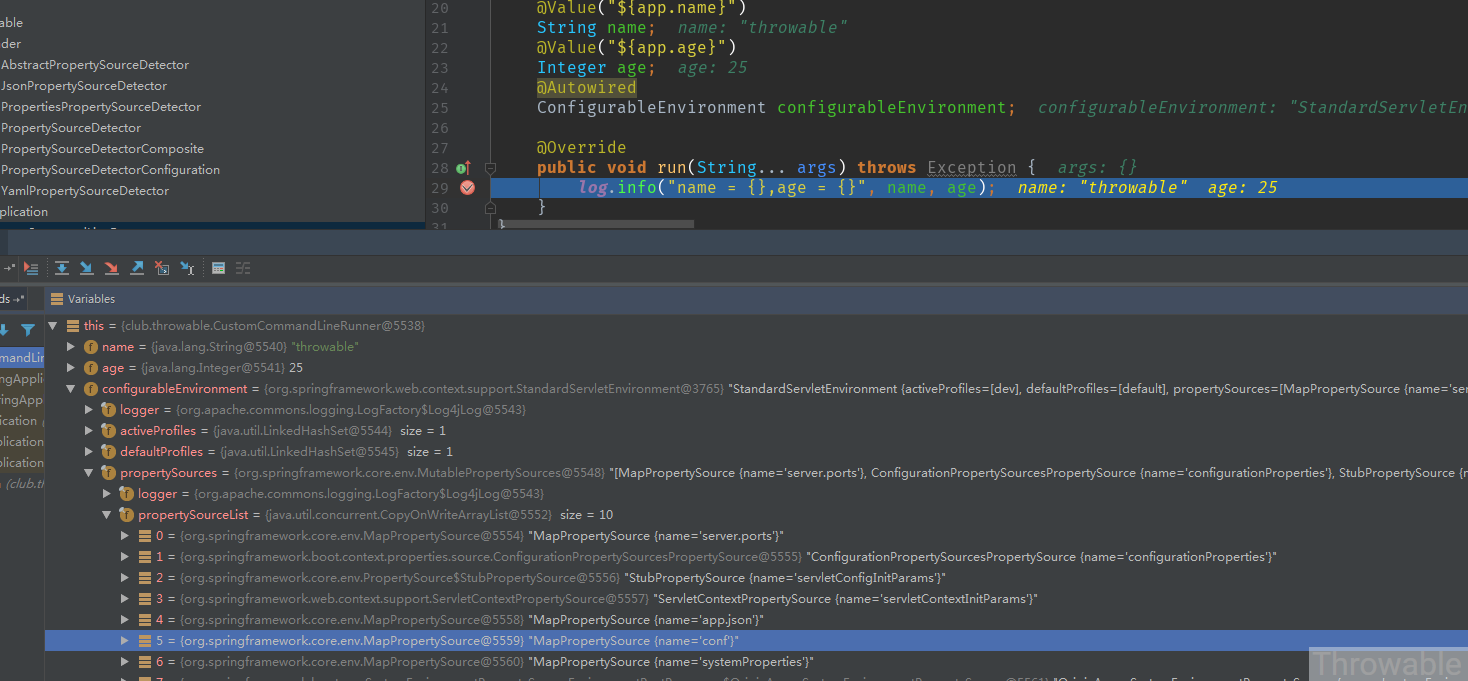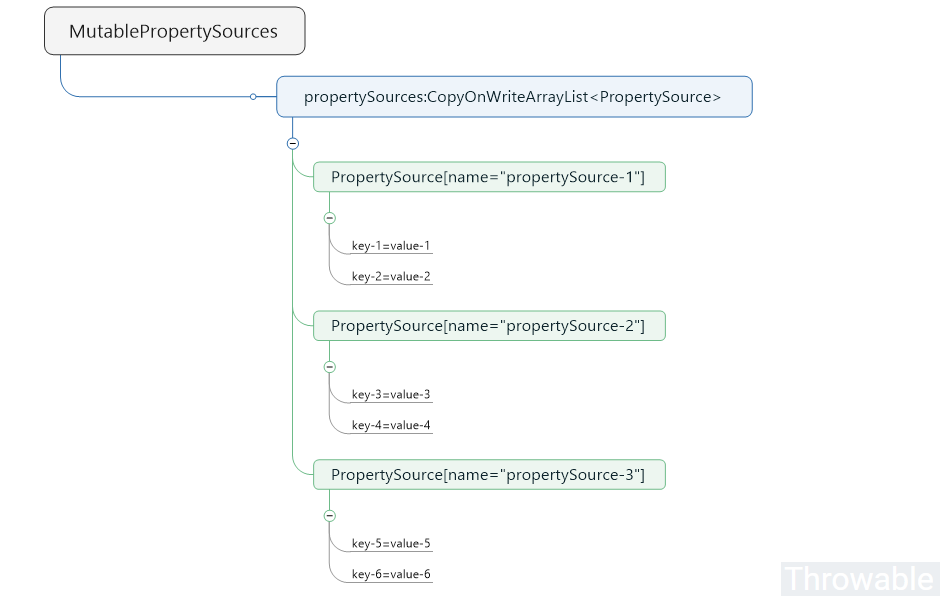您好,登錄后才能下訂單哦!
您好,登錄后才能下訂單哦!
這篇文章給大家分享的是有關基于Spring Boot的Environment源碼如何實現分散配置的內容。小編覺得挺實用的,因此分享給大家做個參考,一起跟隨小編過來看看吧。
前提
org.springframework.core.env.Environment是當前應用運行環境的公開接口,主要包括應用程序運行環境的兩個關鍵方面:配置文件(profiles)和屬性。Environment繼承自接口PropertyResolver,而PropertyResolver提供了屬性訪問的相關方法。這篇文章從源碼的角度分析Environment的存儲容器和加載流程,然后基于源碼的理解給出一個生產級別的擴展。
Environment類體系

PropertyResolver:提供屬性訪問功能。
ConfigurablePropertyResolver:繼承自PropertyResolver,主要提供屬性類型轉換(基于org.springframework.core.convert.ConversionService)功能。
Environment:繼承自PropertyResolver,提供訪問和判斷profiles的功能。
ConfigurableEnvironment:繼承自ConfigurablePropertyResolver和Environment,并且提供設置激活的profile和默認的profile的功能。
ConfigurableWebEnvironment:繼承自ConfigurableEnvironment,并且提供配置Servlet上下文和Servlet參數的功能。
AbstractEnvironment:實現了ConfigurableEnvironment接口,默認屬性和存儲容器的定義,并且實現了ConfigurableEnvironment種的方法,并且為子類預留可覆蓋了擴展方法。
StandardEnvironment:繼承自AbstractEnvironment,非Servlet(Web)環境下的標準Environment實現。
StandardServletEnvironment:繼承自StandardEnvironment,Servlet(Web)環境下的標準Environment實現。
reactive相關的暫時不研究。
Environment提供的方法
一般情況下,我們在SpringMVC項目中啟用到的是StandardServletEnvironment,它的父接口問ConfigurableWebEnvironment,我們可以查看此接口提供的方法:

Environment的存儲容器
Environment的靜態屬性和存儲容器都是在AbstractEnvironment中定義的,ConfigurableWebEnvironment接口提供的getPropertySources()方法可以獲取到返回的MutablePropertySources實例,然后添加額外的PropertySource。實際上,Environment的存儲容器就是org.springframework.core.env.PropertySource的子類集合,AbstractEnvironment中使用的實例是org.springframework.core.env.MutablePropertySources,下面看下PropertySource的源碼:
public abstract class PropertySource<T> {
protected final Log logger = LogFactory.getLog(getClass());
protected final String name;
protected final T source;
public PropertySource(String name, T source) {
Assert.hasText(name, "Property source name must contain at least one character");
Assert.notNull(source, "Property source must not be null");
this.name = name;
this.source = source;
}
@SuppressWarnings("unchecked")
public PropertySource(String name) {
this(name, (T) new Object());
}
public String getName() {
return this.name;
}
public T getSource() {
return this.source;
}
public boolean containsProperty(String name) {
return (getProperty(name) != null);
}
@Nullable
public abstract Object getProperty(String name);
@Override
public boolean equals(Object obj) {
return (this == obj || (obj instanceof PropertySource &&
ObjectUtils.nullSafeEquals(this.name, ((PropertySource<?>) obj).name)));
}
@Override
public int hashCode() {
return ObjectUtils.nullSafeHashCode(this.name);
}
//省略其他方法和內部類的源碼
}源碼相對簡單,預留了一個getProperty抽象方法給子類實現,重點需要關注的是覆寫了的equals和hashCode方法,實際上只和name屬性相關,這一點很重要,說明一個PropertySource實例綁定到一個唯一的name,這個name有點像HashMap里面的key,部分移除、判斷方法都是基于name屬性。PropertySource的最常用子類是MapPropertySource、PropertiesPropertySource、ResourcePropertySource、StubPropertySource、ComparisonPropertySource:
MapPropertySource:source指定為Map實例的PropertySource實現。
PropertiesPropertySource:source指定為Map實例的PropertySource實現,內部的Map實例由Properties實例轉換而來。
ResourcePropertySource:繼承自PropertiesPropertySource,source指定為通過Resource實例轉化為Properties再轉換為Map實例。
StubPropertySource:PropertySource的一個內部類,source設置為null,實際上就是空實現。
ComparisonPropertySource:繼承自ComparisonPropertySource,所有屬性訪問方法強制拋出異常,作用就是一個不可訪問屬性的空實現。
AbstractEnvironment中的屬性定義:
public static final String IGNORE_GETENV_PROPERTY_NAME = "spring.getenv.ignore"; public static final String ACTIVE_PROFILES_PROPERTY_NAME = "spring.profiles.active"; public static final String DEFAULT_PROFILES_PROPERTY_NAME = "spring.profiles.default"; protected static final String RESERVED_DEFAULT_PROFILE_NAME = "default"; private final Set<String> activeProfiles = new LinkedHashSet<>(); private final Set<String> defaultProfiles = new LinkedHashSet<>(getReservedDefaultProfiles()); private final MutablePropertySources propertySources = new MutablePropertySources(this.logger); private final ConfigurablePropertyResolver propertyResolver = new PropertySourcesPropertyResolver(this.propertySources);
上面的propertySources(MutablePropertySources類型)屬性就是用來存放PropertySource列表的,PropertySourcesPropertyResolver是ConfigurablePropertyResolver的實現,默認的profile就是字符串default。
MutablePropertySources的內部屬性如下:
private final List<PropertySource<?>> propertySourceList = new CopyOnWriteArrayList<>();
沒錯,這個就是最底層的存儲容器,也就是環境屬性都是存放在一個CopyOnWriteArrayList<PropertySource<?>>實例中。
MutablePropertySources是PropertySources的子類,它提供了get(String name)、addFirst、addLast、addBefore、addAfter、remove、replace等便捷方法,方便操作propertySourceList集合的元素,這里挑選addBefore的源碼分析:
public void addBefore(String relativePropertySourceName, PropertySource<?> propertySource) {
if (logger.isDebugEnabled()) {
logger.debug("Adding PropertySource '" + propertySource.getName() +
"' with search precedence immediately higher than '" + relativePropertySourceName + "'");
}
//前一個PropertySource的name指定為relativePropertySourceName時候必須和添加的PropertySource的name屬性不相同
assertLegalRelativeAddition(relativePropertySourceName, propertySource);
//嘗試移除同名的PropertySource
removeIfPresent(propertySource);
//獲取前一個PropertySource在CopyOnWriteArrayList中的索引
int index = assertPresentAndGetIndex(relativePropertySourceName);
//添加當前傳入的PropertySource到指定前一個PropertySource的索引,相當于relativePropertySourceName對應的PropertySource后移到原來索引值+1的位置
addAtIndex(index, propertySource);
}
protected void assertLegalRelativeAddition(String relativePropertySourceName, PropertySource<?> propertySource) {
String newPropertySourceName = propertySource.getName();
if (relativePropertySourceName.equals(newPropertySourceName)) {
throw new IllegalArgumentException(
"PropertySource named '" + newPropertySourceName + "' cannot be added relative to itself");
}
}
protected void removeIfPresent(PropertySource<?> propertySource) {
this.propertySourceList.remove(propertySource);
}
private int assertPresentAndGetIndex(String name) {
int index = this.propertySourceList.indexOf(PropertySource.named(name));
if (index == -1) {
throw new IllegalArgumentException("PropertySource named '" + name + "' does not exist");
}
return index;
}
private void addAtIndex(int index, PropertySource<?> propertySource) {
//注意,這里會再次嘗試移除同名的PropertySource
removeIfPresent(propertySource);
this.propertySourceList.add(index, propertySource);
}大多數PropertySource子類的修飾符都是public,可以直接使用,這里寫個小demo:
MutablePropertySources mutablePropertySources = new MutablePropertySources();
Map<String, Object> map = new HashMap<>(8);
map.put("name", "throwable");
map.put("age", 25);
MapPropertySource mapPropertySource = new MapPropertySource("map", map);
mutablePropertySources.addLast(mapPropertySource);
Properties properties = new Properties();
PropertiesPropertySource propertiesPropertySource = new PropertiesPropertySource("prop", properties);
properties.put("name", "doge");
properties.put("gourp", "group-a");
mutablePropertySources.addBefore("map", propertiesPropertySource);
System.out.println(mutablePropertySources);Environment加載過程源碼分析
Environment加載的源碼位于SpringApplication#prepareEnvironment:
private ConfigurableEnvironment prepareEnvironment(
SpringApplicationRunListeners listeners,
ApplicationArguments applicationArguments) {
// Create and configure the environment
//創建ConfigurableEnvironment實例
ConfigurableEnvironment environment = getOrCreateEnvironment();
//啟動參數綁定到ConfigurableEnvironment中
configureEnvironment(environment, applicationArguments.getSourceArgs());
//發布ConfigurableEnvironment準備完畢事件
listeners.environmentPrepared(environment);
//綁定ConfigurableEnvironment到當前的SpringApplication實例中
bindToSpringApplication(environment);
//這一步是非SpringMVC項目的處理,暫時忽略
if (this.webApplicationType == WebApplicationType.NONE) {
environment = new EnvironmentConverter(getClassLoader())
.convertToStandardEnvironmentIfNecessary(environment);
}
//綁定ConfigurationPropertySourcesPropertySource到ConfigurableEnvironment中,name為configurationProperties,實例是SpringConfigurationPropertySources,屬性實際是ConfigurableEnvironment中的MutablePropertySources
ConfigurationPropertySources.attach(environment);
return environment;
}這里重點看下getOrCreateEnvironment方法:
private ConfigurableEnvironment getOrCreateEnvironment() {
if (this.environment != null) {
return this.environment;
}
//在SpringMVC項目,ConfigurableEnvironment接口的實例就是新建的StandardServletEnvironment實例
if (this.webApplicationType == WebApplicationType.SERVLET) {
return new StandardServletEnvironment();
}
return new StandardEnvironment();
}
//REACTIVE_WEB_ENVIRONMENT_CLASS=org.springframework.web.reactive.DispatcherHandler
//MVC_WEB_ENVIRONMENT_CLASS=org.springframework.web.servlet.DispatcherServlet
//MVC_WEB_ENVIRONMENT_CLASS={"javax.servlet.Servlet","org.springframework.web.context.ConfigurableWebApplicationContext"}
//這里,默認就是WebApplicationType.SERVLET
private WebApplicationType deduceWebApplicationType() {
if (ClassUtils.isPresent(REACTIVE_WEB_ENVIRONMENT_CLASS, null)
&& !ClassUtils.isPresent(MVC_WEB_ENVIRONMENT_CLASS, null)) {
return WebApplicationType.REACTIVE;
}
for (String className : WEB_ENVIRONMENT_CLASSES) {
if (!ClassUtils.isPresent(className, null)) {
return WebApplicationType.NONE;
}
}
return WebApplicationType.SERVLET;
}還有一個地方要重點關注:發布ConfigurableEnvironment準備完畢事件listeners.environmentPrepared(environment),實際上這里用到了同步的EventBus,事件的監聽者是ConfigFileApplicationListener,具體處理邏輯是onApplicationEnvironmentPreparedEvent方法:
private void onApplicationEnvironmentPreparedEvent(
ApplicationEnvironmentPreparedEvent event) {
List<EnvironmentPostProcessor> postProcessors = loadPostProcessors();
postProcessors.add(this);
AnnotationAwareOrderComparator.sort(postProcessors);
//遍歷所有的EnvironmentPostProcessor對Environment實例進行處理
for (EnvironmentPostProcessor postProcessor : postProcessors) {
postProcessor.postProcessEnvironment(event.getEnvironment(),
event.getSpringApplication());
}
}
//從spring.factories文件中加載,一共有四個實例
//ConfigFileApplicationListener
//CloudFoundryVcapEnvironmentPostProcessor
//SpringApplicationJsonEnvironmentPostProcessor
//SystemEnvironmentPropertySourceEnvironmentPostProcessor
List<EnvironmentPostProcessor> loadPostProcessors() {
return SpringFactoriesLoader.loadFactories(EnvironmentPostProcessor.class,
getClass().getClassLoader());
}實際上,處理工作大部分都在ConfigFileApplicationListener中,見它的postProcessEnvironment方法:
public void postProcessEnvironment(ConfigurableEnvironment environment,
SpringApplication application) {
addPropertySources(environment, application.getResourceLoader());
}
protected void addPropertySources(ConfigurableEnvironment environment,
ResourceLoader resourceLoader) {
RandomValuePropertySource.addToEnvironment(environment);
new Loader(environment, resourceLoader).load();
}主要的配置環境加載邏輯在內部類Loader,Loader會匹配多個路徑下的文件把屬性加載到ConfigurableEnvironment中,加載器主要是PropertySourceLoader的實例,例如我們用到application-${profile}.yaml文件做應用主配置文件,使用的是YamlPropertySourceLoader,這個時候activeProfiles也會被設置到ConfigurableEnvironment中。加載完畢之后,ConfigurableEnvironment中基本包含了所有需要加載的屬性(activeProfiles是這個時候被寫入ConfigurableEnvironment)。值得注意的是,幾乎所有屬性都是key-value形式存儲,如xxx.yyyy.zzzzz=value、xxx.yyyy[0].zzzzz=value-1、xxx.yyyy[1].zzzzz=value-2。Loader中的邏輯相對復雜,有比較多的遍歷和過濾條件,這里不做展開。
Environment屬性訪問源碼分析
上文提到過,都是委托到PropertySourcesPropertyResolver,先看它的構造函數:
@Nullable
private final PropertySources propertySources;
public PropertySourcesPropertyResolver(@Nullable PropertySources propertySources) {
this.propertySources = propertySources;
}只依賴于一個PropertySources實例,在SpringBoot的SpringMVC項目中就是MutablePropertySources的實例。重點分析一下最復雜的一個方法:
protected <T> T getProperty(String key, Class<T> targetValueType, boolean resolveNestedPlaceholders) {
if (this.propertySources != null) {
//遍歷所有的PropertySource
for (PropertySource<?> propertySource : this.propertySources) {
if (logger.isTraceEnabled()) {
logger.trace("Searching for key '" + key + "' in PropertySource '" +
propertySource.getName() + "'");
}
Object value = propertySource.getProperty(key);
//選用第一個不為null的匹配key的屬性值
if (value != null) {
if (resolveNestedPlaceholders && value instanceof String) {
//處理屬性占位符,如${server.port},底層委托到PropertyPlaceholderHelper完成
value = resolveNestedPlaceholders((String) value);
}
logKeyFound(key, propertySource, value);
//如果需要的話,進行一次類型轉換,底層委托到DefaultConversionService完成
return convertValueIfNecessary(value, targetValueType);
}
}
}
if (logger.isDebugEnabled()) {
logger.debug("Could not find key '" + key + "' in any property source");
}
return null;
}這里的源碼告訴我們,如果出現多個PropertySource中存在同名的key,返回的是第一個PropertySource對應key的屬性值的處理結果,因此我們如果需要自定義一些環境屬性,需要十分清楚各個PropertySource的順序。
擴展-實現分散配置
在不使用SpringCloud配置中心的情況下,一般的SpringBoot項目的配置文件如下:
- src
- main
- resources
- application-prod.yaml
- application-dev.yaml
- application-test.yaml
隨著項目發展,配置項越來越多,導致了application-${profile}.yaml迅速膨脹,大的配置文件甚至超過一千行,為了簡化和劃分不同功能的配置,可以考慮把配置文件拆分如下:
- src
- main
- resources
- profiles
- dev
- business.yaml
- mq.json
- datasource.properties
- prod
- business.yaml
- mq.json
- datasource.properties
- test
- business.yaml
- mq.json
- datasource.properties
- application-prod.yaml
- application-dev.yaml
- application-test.yaml
外層的application-${profile}.yaml只留下項目的核心配置如server.port等,其他配置打散放在/profiles/${profile}/各自的配置文件中。實現方式是:依據當前配置的spring.profiles.active屬性,讀取類路徑中指定文件夾下的配置文件中,加載到Environment中,需要注意這一個加載步驟必須在Spring刷新上下文方法最后一步finishRefresh之前完成(這一點原因可以參考之前在個人博客寫過的SpringBoot刷新上下文源碼的分析),否則有可能會影響到占位符屬性的自動裝配(例如使用了@Value("${filed}"))。
先定義一個屬性探索者接口:
public interface PropertySourceDetector {
/**
* 獲取支持的文件后綴數組
*
* @return String[]
*/
String[] getFileExtensions();
/**
* 加載目標文件屬性到環境中
*
* @param environment environment
* @param name name
* @param resource resource
* @throws IOException IOException
*/
void load(ConfigurableEnvironment environment, String name, Resource resource) throws IOException;
}然后需要一個抽象屬性探索者把Resource轉換為字符串,額外提供Map的縮進、添加PropertySource到Environment等方法:
public abstract class AbstractPropertySourceDetector implements PropertySourceDetector {
private static final String SERVLET_ENVIRONMENT_CLASS = "org.springframework.web."
+ "context.support.StandardServletEnvironment";
public boolean support(String fileExtension) {
String[] fileExtensions = getFileExtensions();
return null != fileExtensions &&
Arrays.stream(fileExtensions).anyMatch(extension -> extension.equals(fileExtension));
}
private String findPropertySource(MutablePropertySources sources) {
if (ClassUtils.isPresent(SERVLET_ENVIRONMENT_CLASS, null) && sources
.contains(StandardServletEnvironment.JNDI_PROPERTY_SOURCE_NAME)) {
return StandardServletEnvironment.JNDI_PROPERTY_SOURCE_NAME;
}
return StandardEnvironment.SYSTEM_PROPERTIES_PROPERTY_SOURCE_NAME;
}
protected void addPropertySource(ConfigurableEnvironment environment, PropertySource<?> source) {
MutablePropertySources sources = environment.getPropertySources();
String name = findPropertySource(sources);
if (sources.contains(name)) {
sources.addBefore(name, source);
} else {
sources.addFirst(source);
}
}
protected Map<String, Object> flatten(Map<String, Object> map) {
Map<String, Object> result = new LinkedHashMap<>();
flatten(null, result, map);
return result;
}
private void flatten(String prefix, Map<String, Object> result, Map<String, Object> map) {
String namePrefix = (prefix != null ? prefix + "." : "");
map.forEach((key, value) -> extract(namePrefix + key, result, value));
}
@SuppressWarnings("unchecked")
private void extract(String name, Map<String, Object> result, Object value) {
if (value instanceof Map) {
flatten(name, result, (Map<String, Object>) value);
} else if (value instanceof Collection) {
int index = 0;
for (Object object : (Collection<Object>) value) {
extract(name + "[" + index + "]", result, object);
index++;
}
} else {
result.put(name, value);
}
}
protected String getContentStringFromResource(Resource resource) throws IOException {
return StreamUtils.copyToString(resource.getInputStream(), Charset.forName("UTF-8"));
}
}上面的方法參考SpringApplicationJsonEnvironmentPostProcessor,然后編寫各種類型配置屬性探索者的實現:
//Json
@Slf4j
public class JsonPropertySourceDetector extends AbstractPropertySourceDetector {
private static final JsonParser JSON_PARSER = JsonParserFactory.getJsonParser();
@Override
public String[] getFileExtensions() {
return new String[]{"json"};
}
@Override
public void load(ConfigurableEnvironment environment, String name, Resource resource) throws IOException {
try {
Map<String, Object> map = JSON_PARSER.parseMap(getContentStringFromResource(resource));
Map<String, Object> target = flatten(map);
addPropertySource(environment, new MapPropertySource(name, target));
} catch (Exception e) {
log.warn("加載Json文件屬性到環境變量失敗,name = {},resource = {}", name, resource);
}
}
}
//Properties
public class PropertiesPropertySourceDetector extends AbstractPropertySourceDetector {
@Override
public String[] getFileExtensions() {
return new String[]{"properties", "conf"};
}
@SuppressWarnings("unchecked")
@Override
public void load(ConfigurableEnvironment environment, String name, Resource resource) throws IOException {
Map map = PropertiesLoaderUtils.loadProperties(resource);
addPropertySource(environment, new MapPropertySource(name, map));
}
}
//Yaml
@Slf4j
public class YamlPropertySourceDetector extends AbstractPropertySourceDetector {
private static final JsonParser YAML_PARSER = new YamlJsonParser();
@Override
public String[] getFileExtensions() {
return new String[]{"yaml", "yml"};
}
@Override
public void load(ConfigurableEnvironment environment, String name, Resource resource) throws IOException {
try {
Map<String, Object> map = YAML_PARSER.parseMap(getContentStringFromResource(resource));
Map<String, Object> target = flatten(map);
addPropertySource(environment, new MapPropertySource(name, target));
} catch (Exception e) {
log.warn("加載Yaml文件屬性到環境變量失敗,name = {},resource = {}", name, resource);
}
}
}子類的全部PropertySource都是MapPropertySource,name為文件的名稱,所有PropertySource都用addBefore方法插入到systemProperties的前面,主要是為了提高匹配屬性的優先級。接著需要定義一個屬性探索者的合成類用來裝載所有的子類:
public class PropertySourceDetectorComposite implements PropertySourceDetector {
private static final String DEFAULT_SUFFIX = "properties";
private final List<AbstractPropertySourceDetector> propertySourceDetectors = new ArrayList<>();
public void addPropertySourceDetector(AbstractPropertySourceDetector sourceDetector) {
propertySourceDetectors.add(sourceDetector);
}
public void addPropertySourceDetectors(List<AbstractPropertySourceDetector> sourceDetectors) {
propertySourceDetectors.addAll(sourceDetectors);
}
public List<AbstractPropertySourceDetector> getPropertySourceDetectors() {
return Collections.unmodifiableList(propertySourceDetectors);
}
@Override
public String[] getFileExtensions() {
List<String> fileExtensions = new ArrayList<>(8);
for (AbstractPropertySourceDetector propertySourceDetector : propertySourceDetectors) {
fileExtensions.addAll(Arrays.asList(propertySourceDetector.getFileExtensions()));
}
return fileExtensions.toArray(new String[0]);
}
@Override
public void load(ConfigurableEnvironment environment, String name, Resource resource) throws IOException {
if (resource.isFile()) {
String fileName = resource.getFile().getName();
int index = fileName.lastIndexOf(".");
String suffix;
if (-1 == index) {
//如果文件沒有后綴,當作properties處理
suffix = DEFAULT_SUFFIX;
} else {
suffix = fileName.substring(index + 1);
}
for (AbstractPropertySourceDetector propertySourceDetector : propertySourceDetectors) {
if (propertySourceDetector.support(suffix)) {
propertySourceDetector.load(environment, name, resource);
return;
}
}
}
}
}最后添加一個配置類作為入口:
public class PropertySourceDetectorConfiguration implements ImportBeanDefinitionRegistrar {
private static final String PATH_PREFIX = "profiles";
@Override
public void registerBeanDefinitions(AnnotationMetadata importingClassMetadata, BeanDefinitionRegistry registry) {
DefaultListableBeanFactory beanFactory = (DefaultListableBeanFactory) registry;
ConfigurableEnvironment environment = beanFactory.getBean(ConfigurableEnvironment.class);
List<AbstractPropertySourceDetector> propertySourceDetectors = new ArrayList<>();
configurePropertySourceDetectors(propertySourceDetectors, beanFactory);
PropertySourceDetectorComposite propertySourceDetectorComposite = new PropertySourceDetectorComposite();
propertySourceDetectorComposite.addPropertySourceDetectors(propertySourceDetectors);
String[] activeProfiles = environment.getActiveProfiles();
ResourcePatternResolver resourcePatternResolver = new PathMatchingResourcePatternResolver();
try {
for (String profile : activeProfiles) {
String location = PATH_PREFIX + File.separator + profile + File.separator + "*";
Resource[] resources = resourcePatternResolver.getResources(location);
for (Resource resource : resources) {
propertySourceDetectorComposite.load(environment, resource.getFilename(), resource);
}
}
} catch (IOException e) {
throw new IllegalStateException(e);
}
}
private void configurePropertySourceDetectors(List<AbstractPropertySourceDetector> propertySourceDetectors,
DefaultListableBeanFactory beanFactory) {
Map<String, AbstractPropertySourceDetector> beansOfType = beanFactory.getBeansOfType(AbstractPropertySourceDetector.class);
for (Map.Entry<String, AbstractPropertySourceDetector> entry : beansOfType.entrySet()) {
propertySourceDetectors.add(entry.getValue());
}
propertySourceDetectors.add(new JsonPropertySourceDetector());
propertySourceDetectors.add(new YamlPropertySourceDetector());
propertySourceDetectors.add(new PropertiesPropertySourceDetector());
}
}準備就緒,在/resources/profiles/dev下面添加兩個文件app.json和conf:
//app.json
{
"app": {
"name": "throwable",
"age": 25
}
}
//conf
name=doge項目的application.yaml添加屬性spring.profiles.active: dev,最后添加一個CommandLineRunner的實現用來觀察數據:
@Slf4j
@Component
public class CustomCommandLineRunner implements CommandLineRunner {
@Value("${app.name}")
String name;
@Value("${app.age}")
Integer age;
@Autowired
ConfigurableEnvironment configurableEnvironment;
@Override
public void run(String... args) throws Exception {
log.info("name = {},age = {}", name, age);
}
}
自動裝配的屬性值和Environment實例中的屬性和預期一樣,改造是成功的。
小結
Spring中的環境屬性管理的源碼個人認為是最清晰和簡單的:從文件中讀取數據轉化為key-value結構,key-value結構存放在一個PropertySource實例中,然后得到的多個PropertySource實例存放在一個CopyOnWriteArrayList中,屬性訪問的時候總是遍歷CopyOnWriteArrayList中的PropertySource進行匹配。可能相對復雜的就是占位符的解析和參數類型的轉換,后者牽連到Converter體系,這些不在本文的討論范圍內。最后附上一張Environment存儲容器的示例圖:

感謝各位的閱讀!關于“基于Spring Boot的Environment源碼如何實現分散配置”這篇文章就分享到這里了,希望以上內容可以對大家有一定的幫助,讓大家可以學到更多知識,如果覺得文章不錯,可以把它分享出去讓更多的人看到吧!
免責聲明:本站發布的內容(圖片、視頻和文字)以原創、轉載和分享為主,文章觀點不代表本網站立場,如果涉及侵權請聯系站長郵箱:is@yisu.com進行舉報,并提供相關證據,一經查實,將立刻刪除涉嫌侵權內容。